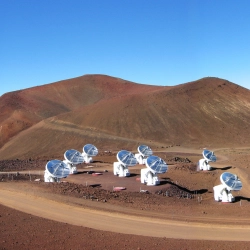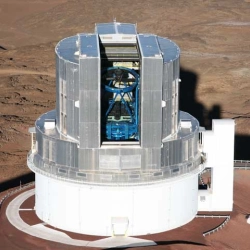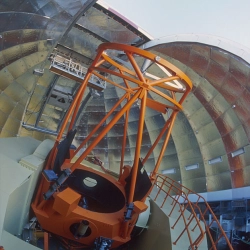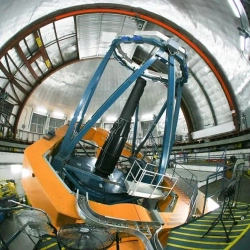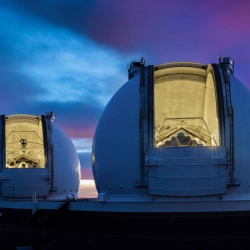The Submillimeter Array (SMA)
Mauna Kea Access Road, Mauna Kea,, Hawai (HI 96720)
United States
The Maunakea Observatories Complex is a group of world-class telescopes located near the summit of Maunakea volcano in Hawaii. Thanks to its ideal conditions for astronomy, it hosts facilities from various countries and is one of the most important observation centers in the world.
Descripción
The Submillimeter Array (SMA) is an advanced radio telescope located at the summit of Mauna Kea in Hawaii, at an altitude of over 4,000 meters. This observatory consists of a set of 8 antennas, each 6 meters in diameter, which work together using a technique known as interferometry. Interferometry allows the antennas to act as a single giant antenna, enhancing the resolution and sensitivity to weak signals, which is crucial in submillimeter astronomy.
The SMA is specifically designed to study submillimeter wavelengths, which fall between far-infrared and microwave radiation in the electromagnetic spectrum. These wavelengths are vital for studying objects in the universe that do not emit visible light, such as molecular clouds where stars are born, cold regions of the interstellar medium, and black holes at the centers of galaxies. Observing in the submillimeter range allows astronomers to explore phenomena such as star formation, galaxy evolution, and dark matter.
One of the most notable features of the SMA is its privileged location on Mauna Kea. This mountain provides exceptional conditions for astronomical observation due to its altitude, dry air, and clear skies. The Earth's atmosphere is less dense at the summit of Mauna Kea, allowing submillimeter waves to reach the telescopes with less distortion, resulting in high-resolution images. This allows the SMA to observe objects billions of light-years away, providing a unique and detailed view of cosmic processes happening in the distant universe.
The SMA has been crucial in major astronomical discoveries. For example, it has allowed the observation of planetary system formation around young stars, providing images of dust disks that may eventually form planets. It has also played a key role in studying colliding galaxies, revealing how galaxies develop and evolve over the history of the universe. Additionally, it has helped investigate supermassive black holes at the centers of galaxies and how they influence their evolution.
The SMA is operated through an international collaboration between the Smithsonian Astrophysical Observatory (SAO) and the Academia Sinica Institute of Astronomy and Astrophysics (ASIAA) from Taiwan. This collaboration enables astronomers from around the world to use the SMA for their research, sharing data and contributing to the advancement of global astronomical knowledge. Through its observations, the SMA continues to be an essential tool for exploring the universe in submillimeter wavelengths, helping to unravel the mysteries of the coldest and most distant parts of the cosmos.
Datos técnicos del telescopio
- Optical System Type: Other
- Mount Type: Other
- Mount Movement Type: Computerized Mount



